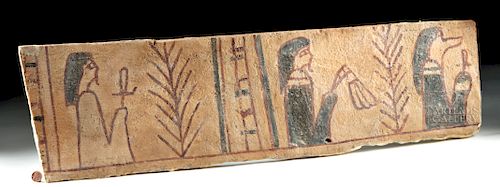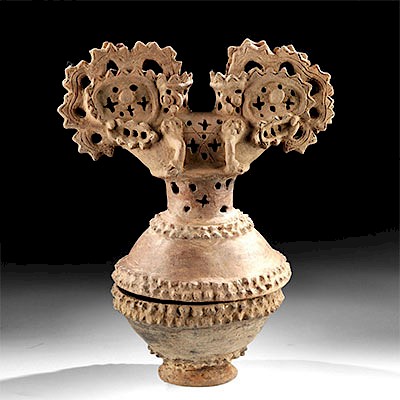Egyptian Wood & Painted Gesso Coffin Panel Fragment
Lot 2a
About Seller
Artemis Fine Arts
686 S Taylor Ave, Ste 106
Louisville, CO 80027
United States
Selling antiquities, ancient and ethnographic art online since 1993, Artemis Gallery specializes in Classical Antiquities (Egyptian, Greek, Roman, Near Eastern), Asian, Pre-Columbian, African / Tribal / Oceanographic art. Our extensive inventory includes pottery, stone, metal, wood, glass and textil...Read more
Estimate:
$5,500 - $8,250
Absentee vs Live bid
Two ways to bid:
- Leave a max absentee bid and the platform will bid on your behalf up to your maximum bid during the live auction.
- Bid live during the auction and your bids will be submitted real-time to the auctioneer.
Bid Increments
| Price | Bid Increment |
|---|---|
| $0 | $25 |
| $300 | $50 |
| $1,000 | $100 |
| $2,000 | $250 |
| $5,000 | $500 |
| $10,000 | $1,000 |
| $20,000 | $2,500 |
| $50,000 | $5,000 |
| $100,000 | $10,000 |
| $200,000 | $20,000 |
About Auction
By Artemis Fine Arts
Aug 22, 2019
Set Reminder
2019-08-22 10:00:00
2019-08-22 10:00:00
America/New_York
Bidsquare
Bidsquare : Fine Ancient | Asian | Ethnographic Art
https://www.bidsquare.com/auctions/artemis-gallery/fine-ancient-asian-ethnographic-art-4348
Featuring classical antiquities, ancient and ethnographic art from cultures encompassing the globe, plus fine art. Egyptian, Greek, Roman, Etruscan, Near Eastern, Asian, Pre-Columbian, Native American, African / Tribal, Oceanic, Spanish Colonial, Russian, Fine Art, so much more! Artemis Fine Arts info@artemisgallery.com
Featuring classical antiquities, ancient and ethnographic art from cultures encompassing the globe, plus fine art. Egyptian, Greek, Roman, Etruscan, Near Eastern, Asian, Pre-Columbian, Native American, African / Tribal, Oceanic, Spanish Colonial, Russian, Fine Art, so much more! Artemis Fine Arts info@artemisgallery.com
- Lot Description
Egypt, Late Dynastic Period, 26th to 31st Dynasty, ca. 664 to 332 BCE. A beautiful sarcophagus panel fragment, of a rectangular form carved from finely-grained cedar wood, with a painted yellow-brown ground. Depicted are three large seated deity figures holding sacred implements of protection used in funerary contexts, one in white holding an ankh; the middle figure in black holding a ceremonial flail (nekhakha); the third seated figure holding an ankh and presents an abstract dog-form head, perhaps a depiction of one of the Sons of Horus, Duamutef. The figures are separated by red-and-blue ladder-form columns as well as two tall palm fronds, both important symbols representing life after death. A small slit-form mortise on the top periphery indicates how the coffin lid was secured to the rest of the body. Size: 31" L x 9" W (78.7 cm x 22.9 cm).
Anthropoid coffins first appeared by the Middle Kingdom - skillfully carved so as to outline the mummy's body and decorated with the visage and wig of the deceased individual. Such coffins not only served to copy the mummy's form kept within, but also served as actual substitutes for the bodies in the event that the mummy's body was lost or destroyed. As time progressed, the panels and carved details which embellished these coffins were decorated with more extensive iconographic programs, presenting a greater number of inscriptions and scenes of deities, protective spells, and important symbology as we see in this example.
Coffins made for higher-status and intellectual individuals were traditionally carved from cedar. Interestingly, cedar wood was not native to Egypt. Egypt did not have verdant forests filled with tall trees, and unfortunately most of its native lumber was of relatively poor quality. So they relied on importing to acquire hardwoods - ebony imported from Africa, cedar and pine from Lebanon. One fabulous obelisk inscription by Thutmose III attests to the luxury of treasured hardwoods. It reads as follows, "They brought to me the choicest products . . . consisting of cedar, juniper and of meru wood . . . all the good sweet woods of God's Land." (Obelisk inscription by Thutmose III - J. H. Breasted, Ancient Records of Egypt, Part Two, p. 321)
Provenance: private Vero Beach, Florida, USA collection; ex-private old New Jersey, USA collection, acquired in the 1960s
All items legal to buy/sell under U.S. Statute covering cultural patrimony Code 2600, CHAPTER 14, and are guaranteed to be as described or your money back.
A Certificate of Authenticity will accompany all winning bids.
We ship worldwide and handle all shipping in-house for your convenience.
#143964This panel is a fragment from a larger wooden coffin. Minor nicks and abrasions to painted details, peripheries, and verso, light encrustations, with fading to original pigmentation, and several areas of light overpainting, otherwise intact and excellent. Nice earthen deposits and great traces of original pigmentation throughout. Remains of old mounting foam on verso.Condition
- Shipping Info
-
All shipping is handled in-house for your convenience. Your invoice from Artemis Gallery will include shipping calculation instructions. If in doubt, please inquire BEFORE bidding for estimated shipping costs for individual items.
-
- Buyer's Premium



 EUR
EUR CAD
CAD AUD
AUD GBP
GBP MXN
MXN HKD
HKD CNY
CNY MYR
MYR SEK
SEK SGD
SGD CHF
CHF THB
THB













